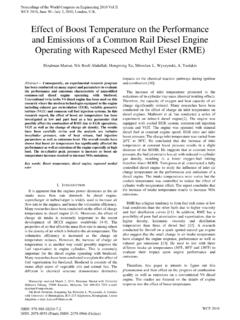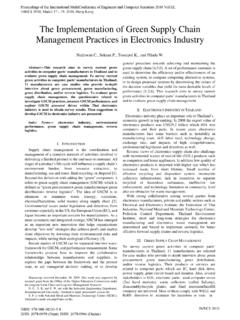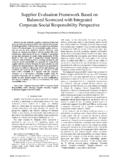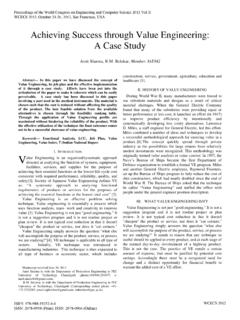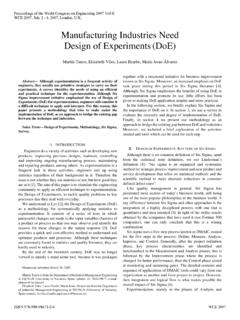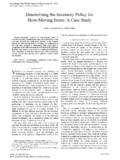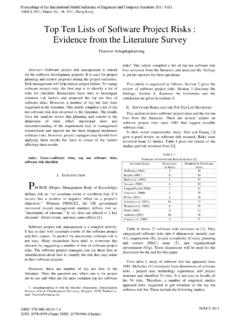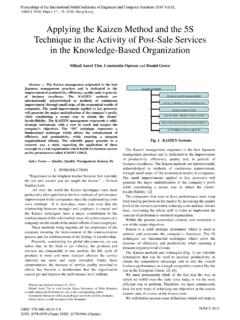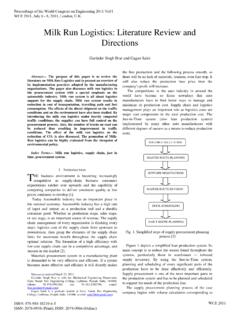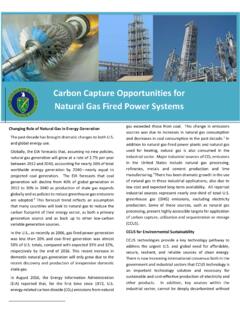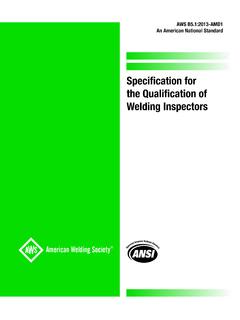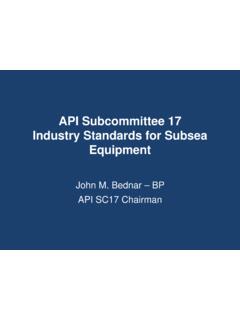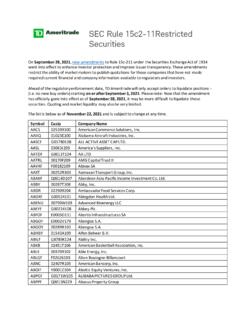Transcription of Accidents in Pressure Vessels: Hazard Awareness
1 Abstract Pressure vessels store substances under Pressure higher than atmospheric conditions and are found all over the place. They are used in homes and hospitals for hot water storage, in many different factories and plants, and in mining and oil refineries. Pressure vessels store large amounts of energy; the higher the operating Pressure and the bigger the vessel, the more the energy released in the event of a rupture and consequently the higher the extent of damage or disaster or the danger it poses, hence there should be no complacency about the risks. Unfortunately, Pressure vessels Accidents happen much more than they should. This paper presents different accounts of Pressure vessels Accidents , Hazard Awareness and precautionary measures that could save lives.
2 Index Terms Accidents , Pressure , Safety, Vessels I. INTRODUCTION Pressure vessels are air-tight containers used mostly in process industry, refinery and petrochemical plant to carry or hold liquid, gases or process fluids. They are typically subjected to Pressure loading and internal or external operating Pressure different from ambient Pressure . Figure 1- 3D Model of a Tower. Figure 2 3D Model of a Drum Manuscript received March 23, 2010. Temilade Ladokun is a PhD student in the School of Science and Engineering at Teesside University, and is employed as a Mechanical Engineer at aker solutions , Stockton Office, UK (e-mail: *Farhard Nabhani is a professor of Biomechanics and Manufacturing at the Teesside University, Middlesbrough, United Kingdom.)
3 (corresponding author s phone: +44 (0) 1642-342-482; fax : +44 (0) 1642 342401 ; e-mail: Sara Zarei is a PhD student in the School of Science and Engineering at Teesside University and is employed as a KTP associate working in a manufacturing SME ( Due to differential operating Pressure of the Pressure vessel, it is potentially dangerous and hazardous. The commonly used types of Pressure vessels in industry are heat exchangers, tanks, towers, boilers, reactors, drums, condensers, piping, and columns as shown in figures 1 6. [1-4] Figure 3- 3D Model of a Heat Exchanger Figure 4 Example of a column Figure 5- 3D Model of a Tank Figure 6 Example of a Condenser Accidents in Pressure Vessels: Hazard Awareness Temilade Ladokun, Farhad Nabhani* and Sara Zarei Proceedings of the World Congress on Engineering 2010 Vol II WCE 2010, June 30 - July 2, 2010, London, : 978-988-18210-7-2 ISSN: 2078-0958 (Print); ISSN: 2078-0966 (Online)WCE 2010 II.))
4 VESSEL DESCRIPTION The arrangement of a process tank vessel is shown in Figure 7. A typical Pressure vessel consists of shell (body of the vessel), closure heads, openings for inspection and instrumentations, attachments and a combination of nozzles for Pressure relief or other purpose, and supports [5]. III. CAUSES OF FAILURE The main causes of failure of a Pressure vessel are as follows: Faulty Design Operator error or poor maintenance Operation above max allowable working pressures Change of service condition Over temperature Safety valve Improper installation Corrosion Cracking Welding problems Erosion Fatigue Stress Improper selection of materials or defects Low water condition Improper repair of leakage Burner failure Improper installation Fabrication error Over pressurisation Failure to inspect frequently enough Erosion Creep Embrittlement Unsafe modifications or alteration Unknown or under investigation IV.
5 RATE OF Accidents Bulk transporter [7] reported that the National Board of Boiler and Pressure Vessel Inspectors recorded the number of Accidents involving Pressure vessels at an increase of 24% over the course of a year between 1999 to 2000. These statistics include power boilers, steam heating boilers, water heating boilers, and unfired Pressure vessels. However, the increased number of Accidents was not reflected through to the number of fatalities, as these actually dropped by 33% over this period. By broadening this search, it can be seen that the reporting period of 1992 to 2001 saw a total of 23,338 Pressure vessel related Accidents which averages at 2,334 Accidents per year. Reporting year 2000 saw the highest number of Accidents at 2,686 with the lowest at 2,011 in 1998. [7-9] The number of fatalities as a direct result of boiler and Pressure vessel Accidents has been recorded as 127 over the past 10 years.
6 [7-9]. During the reported period between 2001 and 2008, the statistics show that the rate of Accidents that were directly linked to Pressure vessels is not yet on the decline. Figure 7: Typical horizontal storage vessel arrangement [6] Proceedings of the World Congress on Engineering 2010 Vol II WCE 2010, June 30 - July 2, 2010, London, : 978-988-18210-7-2 ISSN: 2078-0958 (Print); ISSN: 2078-0966 (Online)WCE 2010 V. Pressure VESSEL RELATED Accidents Below are six examples of major Accidents involving Pressure vessels that have occurred in the past 7 years; Failure of the clamping system on a Pressure vessel lid, which caused the lid to fly off and hit a worker at Clariant Life Science Molecules (UK) Limited s plant in Sandycroft, Flintshire in October 2003. The worker named Giancarlo Coletti sustained serious injuries to his right arm.
7 An explosion at Algeria s largest refinery in port city of Skikda, Algiers. The huge explosion at its key gas installation killed 23 people on 20 January 2004. A Pressure vessel weighing 22680 kg (50,000 pounds) exploded at Marcus Oil in 2004, a Chemical plant in Houston, Texas, throwing heavy fragments into the community, which damaged a church, shattered car windows, nearby buildings experienced significant structural and interior damage due to improper modification and faulty welds of the vessel. Pieces of shrapnel metal weighing over 450kg travelled at extremely high speeds up to a half-mile before landing on nearby highways and railways. A large portion of the plant was destroyed, half the state was without phone or electricity, 3 plant workers were killed and several residents cut by flying glass [10-11].
8 The Buncefield (UK s fifth largest depot) accident on Sunday 12 December 2005 that injured 43 people readily comes to the mind. Twenty petrol tanks were involved in the Buncefield blaze rage; each held three million gallons of fuel. Over 2,000 people were evacuated from the neighbourhood of the depot during the accident. Pressure vessel failure in Houston, United States, in the summer of 2008 killed a veteran supervisor when a heat exchanger exploded in a resin-production facility. Two employees killed at an oil refinery in southeast New Mexico, USA and two others critically injured after a storage tank exploded into flames on 03 March 2010. VI. Hazard Awareness The potential danger associated with Pressure vessels failure if not properly designed, constructed, operated, inspected, tested, or repaired are: Blast Effects Fragmentation damage Suffocation Poisoning Fire Explosion Chemical burns Thermal burns Loss of lives and property Permanent injuries or disabilities on affected people Loss of earning/income Of particular danger are vessels that have been improperly installed, welded or modified and those that lack effective Pressure relief systems [12-13].
9 Even non-dangerous gases and liquids, such as air and water may become hazardous in the event of an accident involving high- Pressure equipment. VII. SAFETY APPROACH There are standards and codes laid down by approved regulatory bodies for the design, construction, welding, testing, marking, operation, inspection, and repair of any Pressure vessel, which provides fundamental safeguards and good safety practices. The standards and codes vary from country to country, the commonly used codes are: ASME Boilers and Pressure Vessel Codes API Standards PD5500 British Standards European Codes and Standards Other International Codes However, some parts of the world do not have Pressure vessel law in place nor provide for the enforcement of internationally recognized Pressure vessel safety codes.
10 This casts doubts on the safety of vessels operating in such places. The Health & Safety Executive (HSE) in the UK has warned of the need for effective operation, inspection and maintenance regimes to ensure the safe use of Pressure equipment. The Chemical Safety Board (CSB) has also echoed the same by asking all jurisdictions to adopt the Pressure Vessel Code and related boiler standards as lives will be saved as a result. [14-15]. VIII. PRECAUTIONARY MEASURES The catastrophic disasters caused by Pressure vessel Accidents could be totally prevented by; Designing, fabricating and constructing Pressure vessels to comply with applicable codes and standards, and where no Pressure vessel law exists, to internationally recognised Pressure vessel safety codes.
